

3 Ways to Integrate Technology into the Classroom. Today’s primary and secondary students are extremely tech savvy, which is why implementing technology in the classroom has become a major focus (and in some cases a major obstacle) for educators.
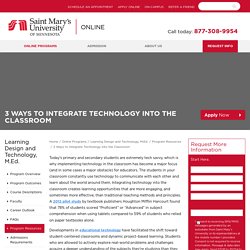
The students in your classroom constantly use technology to communicate with each other and learn about the world around them. Integrating technology into the classroom creates learning opportunities that are more engaging, and sometimes more effective, than traditional teaching methods and principles. A 2012 pilot study by textbook publishers Houghton Mifflin Harcourt found that 78% of students scored “Proficient” or “Advanced” in subject comprehension when using tablets compared to 59% of students who relied on paper textbooks alone.
Developments in educational technology have facilitated the shift toward student-centered classrooms and dynamic project-based learning. How to Make Technology in Classrooms Effective and Exciting. So, you've got a room full of technology—and a mandate to use it.
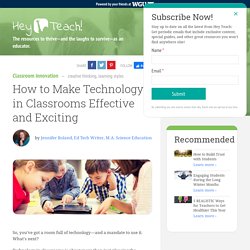
What's next? Technology in classrooms is about more than just pleasing the higher-ups who want to see you realizing value from their investment. New digital tools can help you engage students at all levels, activate multiple learning styles, and provide exciting, memorable activities. 8 Engaging Ways to use Technology in the Classroom to Create Lessons That Aren’t Boring. Are you tired of delivering the same old lectures on the same subjects year after year? Are you using the same lesson materials over and over and wishing you could make learning in your classroom more interactive? While lectures and lessons can be informative and even “edutaining” when delivered with passion and good materials by knowledgeable experts, sadly many traditional lectures and lessons are boring, and even worse often ineffective.
The good news is that the Web is loaded with great free tools that can enable teachers to bring a sense of fun and engagement to their lessons. Of course, you do need devices with Internet access to give these tools a try. How to Integrate Educational Technology Into Schools and Classrooms. Technology is in the classroom already, whether we like it or not: students bring it, in the form of phones and laptops.

We bring it in the same forms. And the power of educational technology to transformatively enhance teaching is becoming clearer. But how should it be done, and what are the advantages? 12 Easy Ways to Use Technology in the Classroom, Even for Technophobic Teachers. Everyone wants teachers to use technology in the classroom. But you're busy -- meeting standards, prepping students for tests -- and maybe you’re not too fond of computers, anyway. How to Use Education Technology - The Ultimate Guide. In his popular book, Ditch That Textbook, Matt Miller argues that the textbook is a relic from the days when teachers were the keepers of knowledge to be delivered to students in healthy doses of lectures and notes.
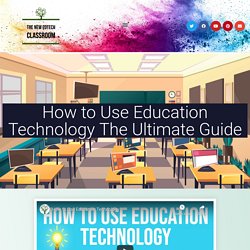
The fact of the matter is that in today’s digital world, educators are no longer the gatekeepers of information, and students know it. Instead, the role of the educator should be to guide students as they navigate the wealth of information available at their fingertips. Breaking free from textbooks doesn’t have to mean doing away with them entirely, but it does mean that educators need to be using relevant digital media to supplement material. Whether we choose to show them or not, students are going to find information online. We should embrace the availability of the vast array of multimedia sources and guide students toward what is the most interesting, relevant, and useful. Technology in the Classroom: Insights for Optimization - Education Elements. In addition to choosing the appropriate hardware for your educational technology needs, it’s important to take a careful approach to software selection.
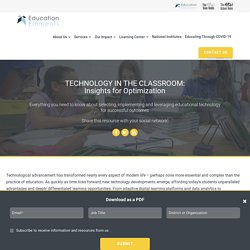
Trying to figure out which digital content curriculum and providers are right for your school or district can be difficult. The market is already diverse and complex enough to overwhelm many teachers or school leaders who are trying to decide which products to choose. Faced with the prospect of selecting content from a market in which new companies crop up every month and each product promises great results, school leaders wonder: Where should we begin? How can we narrow down a short list of content providers from the many that are available? How do we know if a provider will work for our group of students? To help navigate this arena successfully, work on answering the following questions before beginning to search the digital content market:
8 Innovative Ways To Use Technology in Education. Recent research states that the use of technology in education has improved student’s academic performance drastically. Though traditional classroom teaching may still be prevalent, many educational instituitions are coming forward in embracing technologies. For instance, they use digital whiteboards, flipped classrooms and Chromebooks replacing textbooks. And who best to support this movement than teachers themselves?
Here is a list of 8 innovative technology in education ideas to use in the classroom that is transforming the world of education: 1. Text-only slideshow presentations are behind the times due to its monotonous content delivery. How to use technology in the classroom - CAE Computer Aided E-learning. Technology in the classroom now plays a very big role in the effectiveness of education.
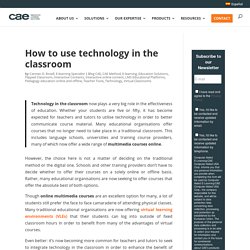
Whether your students are five or fifty, it has become expected for teachers and tutors to utilise technology in order to better communicate course material. Many educational organisations offer courses that no longer need to take place in a traditional classroom. This includes language schools, universities and training course providers, many of which now offer a wide range of multimedia courses online. However, the choice here is not a matter of deciding on the traditional method or the digital one. Schools and other training providers don’t have to decide whether to offer their courses on a solely online or offline basis. Though online multimedia courses are an excellent option for many, a lot of students still prefer the face to face camaraderie of attending physical classes.
7 smart ways to use technology in classrooms. Istock Elementary school teacher Kayla Delzer’s students tweet, post on Instagram and watch YouTube in class.
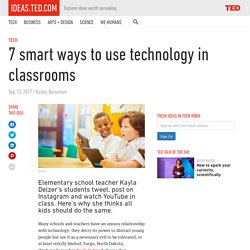
Here’s why she thinks all kids should do the same. Many schools and teachers have an uneasy relationship with technology: they decry its power to distract young people but see it as a necessary evil to be tolerated, or at least strictly limited. Fargo, North Dakota, third-grade teacher Kayla Delzer believes that technology can truly revolutionize education — but only if educators make wise choices about what is used and how it’s used (TEDxFargo Talk: Reimagining Classroom Teachers as Learners and Students as Leaders).
It’s way too late to try to keep tech out of classrooms — or children’s lives. Tech tip #1: Something boring on paper is still boring on a tablet or a laptop. “Using technology simply for the sake of using it is wasteful,” Delzer says. One way that Delzer’s students learn math is by playing an augmented-reality geometry board game called Cyberchase Shape Quest. 25 Easy Ways to Use Technology in the Classroom. Although many technology-based teaching methods and resources effectively engage students and build their skills, many educators encounter difficulties when using technology in the classroom.
Maybe a specific platform is too hard to introduce. Or maybe it won’t run on your devices. Despite the challenges, you likely want to enjoy the benefits that education technology can deliver. Using the ones that best apply to you and your students, and keeping the condensed list on your desk for quick reference, consider these 25 easy ways to use technology in the classroom: Offering a Unique Learning Experience 1. An ambitious way to use technology in the classroom, you can introduce a game-based learning platform.
Most are designed to engage students, enlivening difficult topics and subjects. Prodigy is one, providing math content up to the 8th grade level that’s aligned with curricula across Canada, Australia, England and the United States. Create your free teacher account today! 2. How to Integrate Technology. Below you will find a quick overview with suggestions of what kinds of tools and activities are best matched with various levels of technology access. All of the resources linked to are either free or offer free versions. If your class has an interactive whiteboard and projector: Try interactive websites such as BrainPOP.